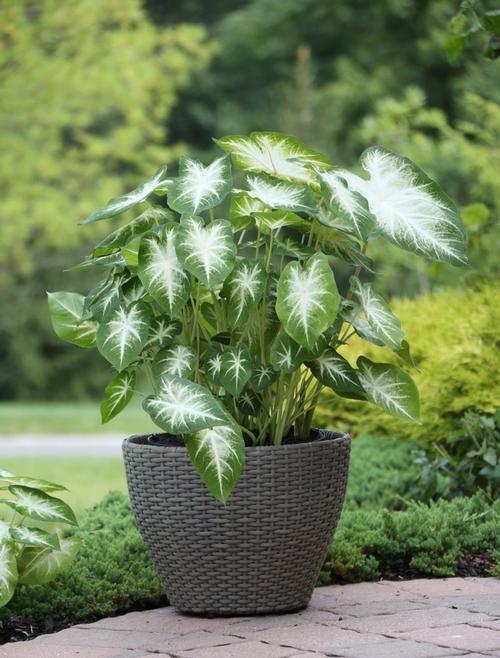EASY SUMMER BULBS FOR SHADY CONTAINERS
Pots and planters can give the shady areas around your home a big lift – especially when you include summer-blooming bulbs, such as elephant ears, caladiums and tuberous begonias. With their exotic flowers and bold foliage, these plants are anything but ho-hum. They can transform a shady entryway, porch, patio or deck into an oasis of color and style.

SHADE-LOVING SUMMER BULBS
Most summer-blooming bulbs are tropical plants that thrive in heat and humidity. Many are also sun worshipers, and for them, the brighter the light and the hotter the temperature, the better they grow. But not all plants thrive in the sun. There are some that prefer growing in shade and these plants are ideal for shady porches, entryways and patios.
Keep in mind that not all shade is equal. Plants growing at the back of a covered porch will get less light than plants growing in the dappled shade beneath a maple tree. The quality of shade also changes according to the time of day, the season and your geographical location. In cool, cloudy climates, some shade-loving bulbs will grow just fine in full day sun. To learn more, read Choosing Plants for Sun or Shade.
Summer bulbs that only need 4-5 hours of sun per day:
Caladiums
Alocasia
Colocasia
Tuberous begonias

Summer bulbs that need 6 or more hours of sun per day:
Asiatic Lilies
Calla lilies
Acidanthera
Heuchera
SOLO PERFORMERS & OUTSTANDING COMPANIONS
Summer-blooming bulbs have big personalities and they can hold their own in a pot or planter. But they also make excellent partners for other bulbs, annuals and perennials. Here are some favorite combinations:
Caladiums with hosta and sweet potato vine
Caladiums with New Guinea impatiens and fuchsia
Alocasia with hakonechloa and creeping Jenny
Alocasia with caladiums
Alocasia with heuchera
Colocasia with coleus and sweet potato vine
Tuberous begonias with lobelia and coleus
Tuberous begonias with torenia

CHOOSING THE RIGHT SIZE POT OR PLANTER
Small bulbs sometimes grow into very large plants. The list below suggests the minimum amount of growing space required by each type of summer-blooming bulb. The larger the pot, the easier it is for a plant to reach its full potential. Larger pots also hold more soil and moisture, so you won’t need to water as often.
If you are combining summer-blooming bulbs with annuals or perennials, make sure the pot is large enough to accommodate all of the plants when they are at their mature size. Cold climate gardeners can get a jump on the season by starting caladium, elephant ears and begonias indoors, at least a month before the last frost date. The recommendations below are for the minimum pot size. Using a larger container will usually give you a larger plant.
Caladiums 4 bulbs = 8-inch diameter pot
Elephant Ears 1 tuber = 16-inch diameter pot
Begonias 1 bulb = 6-inch diameter pot

GOOD SOIL, PLENTY OF WATER AND REGULAR FERTILIZER
For best results, fill your pots and planters with a light, good quality potting soil or soilless growing mix. Using a blend that contains peat moss, vermiculite or perlite will help keep the root zone aerated. Avoid using garden soil in your containers; with frequent watering it becomes too dense for healthy root growth.
In hot weather, plants in containers will need daily watering. Once or twice a week, take a few minutes extra to water slowly, making sure the entire root ball gets fully soaked. In rainy climates, avoid using saucers, which can accumulate standing water. Instead, raise pots on bricks or pot feet to encourage good drainage.
Summer-blooming bulbs are high-energy plants. Fertilizing them throughout the growing season will sustain rapid growth and encourage abundant flowering. Use a liquid all-purpose fertilizer or a granular sustained release fertilizer and follow package directions for application rates.


